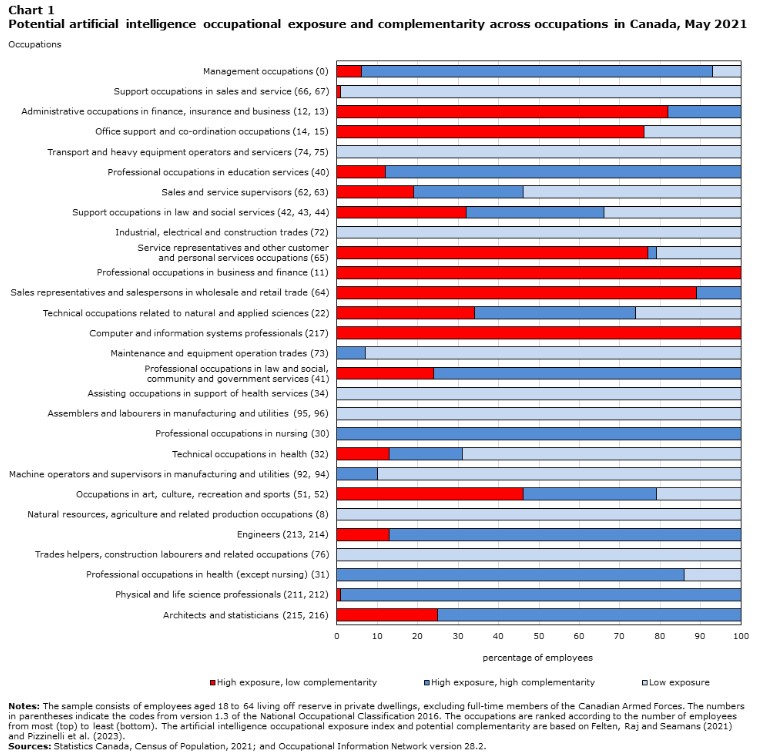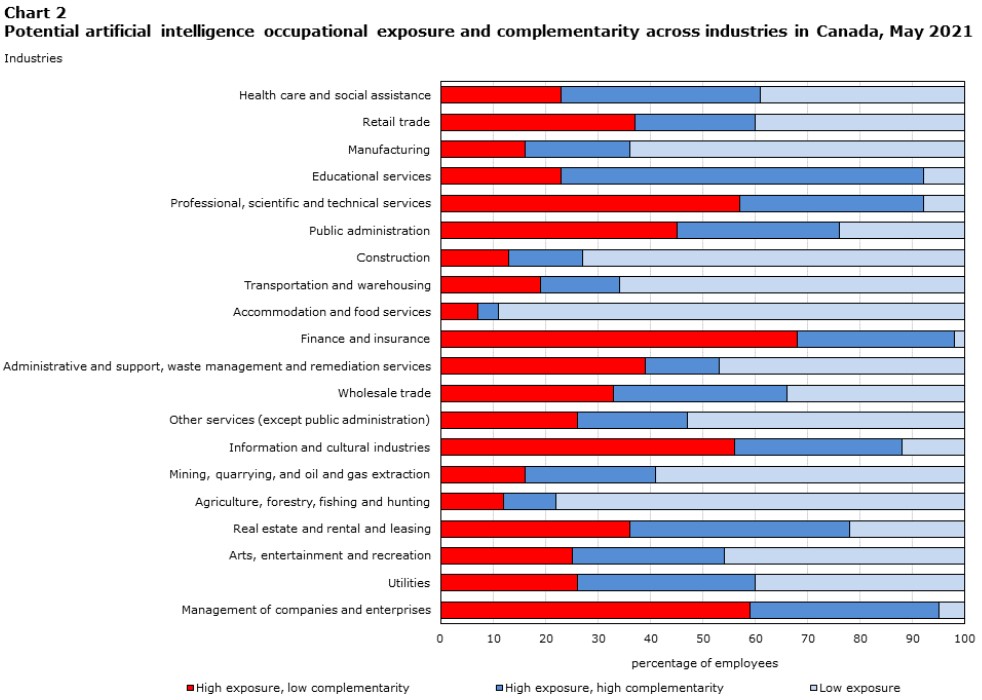Which professions, industries could see greatest impact of AI?

The rise of artificial intelligence (AI) in the work sphere is more likely to transform the jobs of workers who are more highly educated, according to a report from Statistics Canada (StatCan).
“This is contrary to prior waves of technological transformation, which mainly affected less educated workers.”
The study distinguishes three types of workers: those whose jobs are highly exposed to AI and who might benefit from it because of a high degree of complementarity between their tasks and AI capabilities; those whose jobs are highly exposed to AI and whose tasks might be replaced by AI; and those whose jobs are not highly exposed to AI.
In May 2021, on average, roughly 4.2 million employees (31 per cent) in Canada were in the high exposure and low complementarity with AI group.
Meanwhile, about 3.9 million (29 per cent) were in the high exposure and high complementarity jobs. About 5.4 million (40 per cent) were in the third group.
Education and exposure to AI
The highest shares of high-exposure, low-complementarity jobs are held by employees with a bachelor’s degree (37 per cent) or a college, CEGEP or other certificate or diploma below a bachelor’s degree (36 per cent), followed by those with a graduate degree (32 per cent), high school or less education (25 per cent), and an apprenticeship or trades certificate or diploma (15 per cent).
Employees with a bachelor’s degree or higher were more likely to hold jobs that may be highly complementary with AI than those with an education below the bachelor’s degree level, as long as the potential beneficiaries of AI possess the necessary skills.
“Educational attainment has historically been one of the most important indicators of whether a worker will be resilient to technological shocks. The growing consensus from the labour economics literature is that less educated workers face a higher risk of automation-related job transformation than highly educated workers because the former group is more likely to perform routine and manual tasks that are more susceptible to being automated,” said StatCan.

Source: Statistics Canada (StatCan)
StatCan’s data show that employees with an apprenticeship or trades certificate or diploma may be less exposed to AI-related job transformation, as 73 per cent among them were in low-exposure occupations.
“A more nuanced view is that while less educated workers may face potentially lower exposure to AI-related job transformation, highly educated workers from high-exposure jobs may transition to low-exposure jobs, displacing less educated workers,” said StatCan.
Most professionals say that AI is putting more work on their plate, according to a previous report.
What professions could see greatest impact from AI?
Occupations belonging to the high exposure and low complementarity with AI group included professional occupations in business and finance, computer and information system professionals, and sales representatives and sales persons in wholesale and retail trade, according to StatCan.
Meanwhile, those belonging to the high exposure and high complementarity group included management occupations, physical and life sciences professionals, and professional occupations in education services. 
Source: Statistics Canada (StatCan)
“Interestingly, among the 28 occupations, computer and information systems professionals experienced the highest growth (39%) from May 2016 to May 2021. However, this does not necessarily mean that computer and information systems professionals will be in less demand in the future because of AI,” said StatCan.
“While these professionals may be in high-exposure, low-complementarity jobs, they are integral to maintaining and improving the underlying AI infrastructure, and this may lead to the creation of new tasks or jobs.”
Few change management professionals are using AI for work, according to another report.
What industries are most affected by AI?
When it comes to different industries, more than half of employees in the following industries were in high-exposure, low-complementarity jobs: professional, scientific and technical services; finance and insurance; and information and cultural industries, according to StatCan.
In contrast, educational services, and health care and social assistance employed proportionately more employees who may be beneficiaries of AI.

Source: Statistics Canada (StatCan)
“It is important to note that these experimental estimates of AI occupational exposure are based on a limited number of AI applications and how they might interact with some human abilities,” noted StatCan.
“The set of tasks which AI might be able to perform fully unsupervised might grow in the future with technological advancement. As such, the applicability of the index used in this study might decrease over time and therefore the experimental estimates presented in this study should be interpreted with caution.”
Nearly half (48 per cent) of employers feel their employees are barely or not at all prepared to use AI or Generative AI.




